 Having had the opportunity to meet Tricia Ebarvia in person at a Teaching Tolerance workshop in June, I have been reading her #DisruptTexts tweets and posts with interest, admiration and a little envy. A former English major, a part of my heart has always stayed in the literature place, and I love the work that Tricia and others are doing to transform the teaching of ELA into a more equitable practice. I am not without envy, however, because this path – content-wise – does not seem as clear to me as a teacher of mathematics, even though this work has been the lion’s share of my professional development for the last five or six years, and has been on my radar even longer. When I was a second year teacher in 2007, I discovered Jonathan Osler’s Radical Math curriculum on line, and volunteered to teach an elective course at my school with the same name. I borrowed liberally from Osler’s curriculum, incorporated a unit of study around the Jena 6, and the class – populated with students in need of ‘just one more math credit’ – was marked with lively discussion and high engagement. Unfortunately, since that time, I have not had that degree of freedom in creating my own curriculum and refining my early efforts; I teach in New York, land of the Regents Exam.
Having had the opportunity to meet Tricia Ebarvia in person at a Teaching Tolerance workshop in June, I have been reading her #DisruptTexts tweets and posts with interest, admiration and a little envy. A former English major, a part of my heart has always stayed in the literature place, and I love the work that Tricia and others are doing to transform the teaching of ELA into a more equitable practice. I am not without envy, however, because this path – content-wise – does not seem as clear to me as a teacher of mathematics, even though this work has been the lion’s share of my professional development for the last five or six years, and has been on my radar even longer. When I was a second year teacher in 2007, I discovered Jonathan Osler’s Radical Math curriculum on line, and volunteered to teach an elective course at my school with the same name. I borrowed liberally from Osler’s curriculum, incorporated a unit of study around the Jena 6, and the class – populated with students in need of ‘just one more math credit’ – was marked with lively discussion and high engagement. Unfortunately, since that time, I have not had that degree of freedom in creating my own curriculum and refining my early efforts; I teach in New York, land of the Regents Exam.
When I saw Dylan Kane’s post, Disrupt Math, thus, my interest was naturally piqued; I have been thinking to myself the last few weeks “Why don’t we have a hashtag like that? Where is this conversation in the #MTBoS?” Like Dylan, I am aware of the MTBoS Book Club, but the reading schedule during the school year was more with which I could realistically keep pace. Many of us are talking about equity, posting about equity, tweeting about equity. And that is important. But the conversation, in my mind, needs to develop some focus, or foci, because it is all too easy for us (and by us, I am referring to the white teaching community) to raise the banner of equity, proclaim ourselves proponents of social justice, consider ourselves woke, and assume our awareness is where it needs to be.
I want to conversations that center the learning of mathematics, and how all of our students should and can learn math, and what changes we, as individuals, can make in our classrooms and math departments to create spaces that are more equitable than the ones that currently exist. I want to share strategies and practices that ensure that all students are given voice in the mathematics classroom – things like mathographies and name tents, visibly random groupings, and vertical non-permanent surfaces. I need ideas for allowing this space to exist inside a classroom and school and system which lives by standardized testing, a place where I may need or want to stay for a myriad of reasons, one of which is not abandoning the students of color who remain there.
But before we do that, or while we are doing that, we need to ‘take fearless inventory’ of ourselves (referring again to my white colleagues) and of the system by which we benefit, and of which we are inexorably a part – the white supremacist system that runs on deeply embedded structural racism. Until we do that, in my view, we are only giving lip service to the idea of equity.
We need to let go of our imagined exemptions from this despicable system when educating ourselves – I am female, I am gay/trans, I am Jewish (or Italian, or Irish…), I have chronic health conditions – whatever you think your passport out of this may be, forget it. If we are white, we benefit from racist structures, and have privilege in too many ways to enumerate, or maybe even perceive. We need to work on lifting the veil for ourselves in order to equitably serve all of our students, else we run the very real risk of becoming well-meaning white saviours – something many of us were taught to be in our alternative teacher training programs. Well-meaning white folk are not going to help, and may even make things worse in the ignorance with which they approach the work.
So how do we do this? There is no recipe, no list of steps one can take, because this is a process, and the work is – wait for it – endless. (Sorry.) But like any process of evolution, there are levels of awareness we will reach as we re-educate ourselves. And while the picture of American whiteness and its concomitant history may be difficult with which to live and imagine yourself a part, I have found that it is the only way to proceed honestly.
I am not any kind of an expert. I am a middle-aged, cisgendered, straight, lapsed-Jewish white woman with health issues, who, recognizing that it was not my job to ‘save’ my students but rather to educate them as best I could, has taken upon a course of self-study in order to honestly see myself and the system in which I operate. I am grateful for anyone who has (knowingly or not) pointed me in the direction of resources with which to educate myself, or who has shared themselves and their stories with me – on Twitter, through blogs, PLTs, workshops – so that I might further open my eyes, and hopefully, help others open theirs.
Here are some resources I have used/am using/recommend:
Seeing White – Season 2 from the podcast SceneOn Radio, which explores how whiteness was created and has been maintained in America. Required listening, in my opinion.
White Fragility by Robin Diangelo – I am only several chapters in to this book, but every paragraph holds some resounding truth.
Undoing Racism – a workshop offered by People’s Institute for Survival and Beyond
Revisionist History – Season1, Episodes 4 and 5, and Season 2, Episode 3 – These episodes from Malcolm Gladwell’s podcast explore how our educational system systematically overlooks students of promise who are poor and frequently people of color, as well as a deep dive into Brown vs. Board of Education.
Learning to Be White: Money, Race and God in America by Thandeka – this book by a Unitarian Universalist Theologian and journalist, explores the politics of between white in America.
This is a very short list of a myriad of books that I have read over the last ten years which have contributed to my growing awareness of my whiteness and the structural racism of which I am unwittingly yet undeniably a part. However, these particular books and podcasts have given me the clearest mirror in which to look. (Additionally, I am writing this post from Lake Dunmore in Vermont, and don’t have access to my bookshelves.)
I started out writing in response to Dylan’s post, and I want to go back there. Dylan poses three questions he would like to further discuss in order to explore how to achieve greater equity in mathematics:
Who practices mathematics?
How is mathematical knowledge created?
What does it mean to practice mathematics?
I think these are worthy questions which can help us as a teaching community begin to disrupt mathematics teaching as it currently exists in the United States (to make a sweeping generalization). But I believe that until we understand how we are cogs in what has become a self-maintaining wheel, and how we might disrupt the operation of that wheel, we cannot fully grasp, and thus begin to correct, the inequities in math education.




 Having had the opportunity to meet
Having had the opportunity to meet 
 As I open up this draft page, WordPress prompts me to “Share your story here…”, and I immediately ask myself how much I want to actually share. I haven’t been writing much this year because most of what I’ve been thinking about and dealing with has been deeply personal and not laundry I care to air publicly (though I realize that allusion might in fact be hypocritical by definition). But
As I open up this draft page, WordPress prompts me to “Share your story here…”, and I immediately ask myself how much I want to actually share. I haven’t been writing much this year because most of what I’ve been thinking about and dealing with has been deeply personal and not laundry I care to air publicly (though I realize that allusion might in fact be hypocritical by definition). But and going BACK to teaching things the way I believe they should be taught – with inquiry, discovery, and with a deeply conceptual approach. I have a couple of BIG things I need to keep in mind while I am doing this – first of all, my school is not annualized, at least not for Algebra 2. This means my students will leave me at the end of the fall term, and I will get a mostly new crop of kiddies at the beginning of February. Second, they still need to take that darn Regents exam, and get a grade by which both of us will be evaluated – and that evaluation will stick with them (on their permanent transcript) longer than it will with me (I get re-evaluated each year, with every batch of scores). But here’s something else I know for sure – I can train people to do well on tests. Years of teaching AND tutoring have helped me hone some very fine test prep skills. If I am teaching for deep understanding, then test prep should be – well, maybe not a breeze, but it should follow the learning without too much trouble.
and going BACK to teaching things the way I believe they should be taught – with inquiry, discovery, and with a deeply conceptual approach. I have a couple of BIG things I need to keep in mind while I am doing this – first of all, my school is not annualized, at least not for Algebra 2. This means my students will leave me at the end of the fall term, and I will get a mostly new crop of kiddies at the beginning of February. Second, they still need to take that darn Regents exam, and get a grade by which both of us will be evaluated – and that evaluation will stick with them (on their permanent transcript) longer than it will with me (I get re-evaluated each year, with every batch of scores). But here’s something else I know for sure – I can train people to do well on tests. Years of teaching AND tutoring have helped me hone some very fine test prep skills. If I am teaching for deep understanding, then test prep should be – well, maybe not a breeze, but it should follow the learning without too much trouble. applicable
applicable I do, inside the classroom and out of it, and that is doing everything I can to disrupt systems of racism and white supremacy, particularly as they affect my students in my classroom. My summer plans include participating in (while facilitating!) a workshop on how these systems show up in my classroom and what actions I can take to undermine them in service of equity of opportunity for my students, past, present and future. Further, I hope to start a
I do, inside the classroom and out of it, and that is doing everything I can to disrupt systems of racism and white supremacy, particularly as they affect my students in my classroom. My summer plans include participating in (while facilitating!) a workshop on how these systems show up in my classroom and what actions I can take to undermine them in service of equity of opportunity for my students, past, present and future. Further, I hope to start a  Critical Friends group at school in the fall, the goal of which would be to open up conversations about inequities at school, systemic changes which need to be made, and how to begin effecting those changes. I’m writing about it here to hold myself accountable.
Critical Friends group at school in the fall, the goal of which would be to open up conversations about inequities at school, systemic changes which need to be made, and how to begin effecting those changes. I’m writing about it here to hold myself accountable.

 This may be the most difficult post I have written, but I am committed to writing it, because, as
This may be the most difficult post I have written, but I am committed to writing it, because, as 
 Dr. Martin’s talk addressed the brilliance of black children that goes unacknowledged, undermined, even attacked in our [mathematics] classrooms, and the violence and dehumanization on so many levels in [mathematics] education, which is rooted in both anti-Blackness and white supremacy. He asserted repeatedly (and correctly) that efforts at reform and discourses around equity in mathematics education manage to sustain themselves despite their failure to “respond to Black oppression and dehumanization” [quoting his slides] and ultimately preserve the status quo.
Dr. Martin’s talk addressed the brilliance of black children that goes unacknowledged, undermined, even attacked in our [mathematics] classrooms, and the violence and dehumanization on so many levels in [mathematics] education, which is rooted in both anti-Blackness and white supremacy. He asserted repeatedly (and correctly) that efforts at reform and discourses around equity in mathematics education manage to sustain themselves despite their failure to “respond to Black oppression and dehumanization” [quoting his slides] and ultimately preserve the status quo.







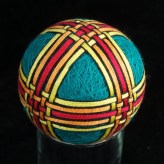 mathematically.
mathematically.
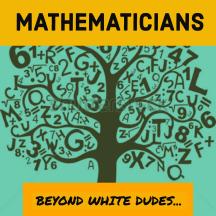 comments on name tents, successful ‘stand and talks’, the launching of “Mathematicians Beyond White Dudes”, and the “What is Math?” lesson. The last two in this list, I am convinced, has won me some engagement for which I might have otherwise needed to fight, if indeed those students were willing to become involved at all in my math madness. And I owe debts to
comments on name tents, successful ‘stand and talks’, the launching of “Mathematicians Beyond White Dudes”, and the “What is Math?” lesson. The last two in this list, I am convinced, has won me some engagement for which I might have otherwise needed to fight, if indeed those students were willing to become involved at all in my math madness. And I owe debts to  educational experience of my students, hereinafter occasionally referred to as “the kiddies,” with great affection. I have hesitated to blog about all this, because I am standing on a lot of shoulders, and don’t want to claim someone else’s genius as my own (that, and the fact that my body is screaming from the enforced transition from an 8 am wake-up time, to 5:15 am, or, as appropriately dubbed by my
educational experience of my students, hereinafter occasionally referred to as “the kiddies,” with great affection. I have hesitated to blog about all this, because I am standing on a lot of shoulders, and don’t want to claim someone else’s genius as my own (that, and the fact that my body is screaming from the enforced transition from an 8 am wake-up time, to 5:15 am, or, as appropriately dubbed by my  I began the lesson with a number puzzle above – it involved three numbers, didn’t necessarily require a system with three variables to solve. The kiddies got busy as soon as they entered the room. Several did write systems with three variables, and quickly substituted into them. Jonathan, my super-eager, super bright 9th grader in Algebra 2, asked if he ‘was allowed’ to solve it with just one variable. Pretty quickly, students arrived at solutions, and wanted to share them. We put some work on the board, discussed all the different strategies involved – guess and check, elimination, substitution – everything we had used when reviewing systems with 2 variables for the last two days.
I began the lesson with a number puzzle above – it involved three numbers, didn’t necessarily require a system with three variables to solve. The kiddies got busy as soon as they entered the room. Several did write systems with three variables, and quickly substituted into them. Jonathan, my super-eager, super bright 9th grader in Algebra 2, asked if he ‘was allowed’ to solve it with just one variable. Pretty quickly, students arrived at solutions, and wanted to share them. We put some work on the board, discussed all the different strategies involved – guess and check, elimination, substitution – everything we had used when reviewing systems with 2 variables for the last two days. examples of what the result of each step might result be. I learned last year that it was crucial to the success of this task to be explicit – despite my faith in my students’ abilities, they needed some translation of what I was looking for; this leg up and the experience of the warm-up gave them enough support to begin to play without me telling them exactly what to do. The room was BUZZING. The kids debated which numbers to choose. They debated which variables to use.
examples of what the result of each step might result be. I learned last year that it was crucial to the success of this task to be explicit – despite my faith in my students’ abilities, they needed some translation of what I was looking for; this leg up and the experience of the warm-up gave them enough support to begin to play without me telling them exactly what to do. The room was BUZZING. The kids debated which numbers to choose. They debated which variables to use.  They wrote the systems and then tested them. Twice. And then I gave each group a small whiteboard on which to write their system. The groups swapped boards, and tried to find solutions. There were heads together, signaling across the room. Not a phone in sight. And I heard lots of great talk – students justifying to one another, arguing with each other. No one needed my help, so I walked around eavesdropping, and grinning. There was frustration and struggle, but the
They wrote the systems and then tested them. Twice. And then I gave each group a small whiteboard on which to write their system. The groups swapped boards, and tried to find solutions. There were heads together, signaling across the room. Not a phone in sight. And I heard lots of great talk – students justifying to one another, arguing with each other. No one needed my help, so I walked around eavesdropping, and grinning. There was frustration and struggle, but the  kiddies were so motivated to figure things out, that they took that frustration and used it to fuel another attempt. They took pictures of the whiteboards so they could continue working on them later. And I could see that the class NOW was truly primed for solving the more difficult systems that they will encounter on the state assessment. As the end of the period drew near, I presented an example of the type of system we would be working on next week, just to get them thinking. When the bell rang, several students stayed behind, continuing to work/argue/get excited about solving the systems they had traded with one another.
kiddies were so motivated to figure things out, that they took that frustration and used it to fuel another attempt. They took pictures of the whiteboards so they could continue working on them later. And I could see that the class NOW was truly primed for solving the more difficult systems that they will encounter on the state assessment. As the end of the period drew near, I presented an example of the type of system we would be working on next week, just to get them thinking. When the bell rang, several students stayed behind, continuing to work/argue/get excited about solving the systems they had traded with one another.










 had work to do my whole life, and maybe now I’m finally getting around to doing it. Thus, burnout: burnout regarding Regents preparation, burnout regarding credit recovery, burnout regarding the recently revised NYS mathematics standards after what can be described as a PAINFUL roll-out of the Common Core, burnout of whatever the buzzword of the year might be: differentiation, depth of knowledge, flexible groupings, performance assessment.
had work to do my whole life, and maybe now I’m finally getting around to doing it. Thus, burnout: burnout regarding Regents preparation, burnout regarding credit recovery, burnout regarding the recently revised NYS mathematics standards after what can be described as a PAINFUL roll-out of the Common Core, burnout of whatever the buzzword of the year might be: differentiation, depth of knowledge, flexible groupings, performance assessment. And yet, I
And yet, I 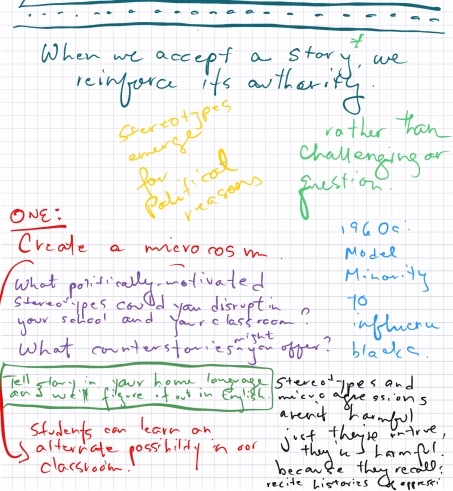


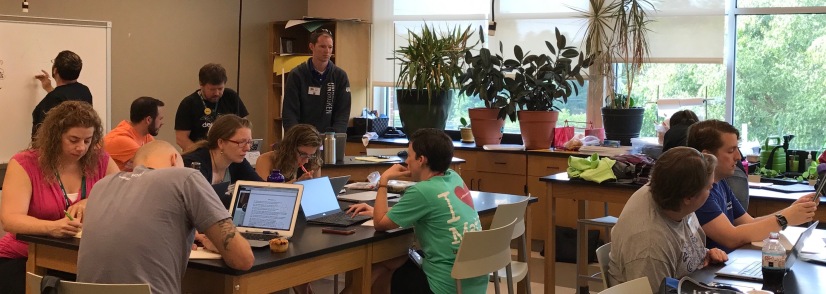
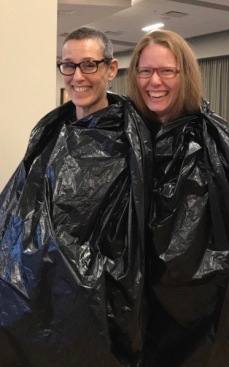
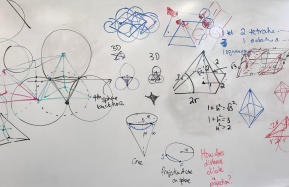
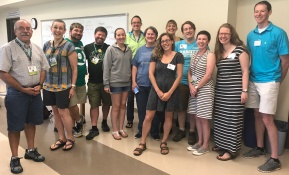

 Henri Picciotto,
Henri Picciotto,  n your classroom; students need to hear “you can learn if I give you TIME”.
n your classroom; students need to hear “you can learn if I give you TIME”.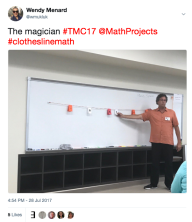 in front of a class, had 30 teachers late in the afternoon, after a full day of intense workshopping and professional learning, oohing and aahing over the deep connections that can be made (and even deeper misunderstandings that can be revealed) with this easily assembled interactive tool. One group in the classroom is working on the clothesline, but everyone else has whiteboards and has their eyes on the prize – 100%participation and engagement. Of course, Chris is the Clothesline Master, with the patter to go with it, but after the hour (which flew by) in his workshop, I felt emboldened enough to make Clothesline Math my
in front of a class, had 30 teachers late in the afternoon, after a full day of intense workshopping and professional learning, oohing and aahing over the deep connections that can be made (and even deeper misunderstandings that can be revealed) with this easily assembled interactive tool. One group in the classroom is working on the clothesline, but everyone else has whiteboards and has their eyes on the prize – 100%participation and engagement. Of course, Chris is the Clothesline Master, with the patter to go with it, but after the hour (which flew by) in his workshop, I felt emboldened enough to make Clothesline Math my  different content (as the titles suggest), but both enriching, mind-expanding, and thought-provoking. And both opportunities to learn from people who I admire greatly.
different content (as the titles suggest), but both enriching, mind-expanding, and thought-provoking. And both opportunities to learn from people who I admire greatly.









 new, running a workshop, maybe I just wasn’t ENTHUSIASTIC ENOUGH for the TMC lovefest. But from the moment I connected with my aquarium buds in the lobby of the hotel until I dropped my final riders off on Saturday afternoon, I felt embraced and accepted – whoever or whatever I am – it’s ENOUGH. And that seems to be the overriding message – one that I hear loud and clear even though sadly I was not able to stay for Lisa Henry’s closing remarks.
new, running a workshop, maybe I just wasn’t ENTHUSIASTIC ENOUGH for the TMC lovefest. But from the moment I connected with my aquarium buds in the lobby of the hotel until I dropped my final riders off on Saturday afternoon, I felt embraced and accepted – whoever or whatever I am – it’s ENOUGH. And that seems to be the overriding message – one that I hear loud and clear even though sadly I was not able to stay for Lisa Henry’s closing remarks.